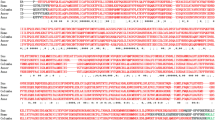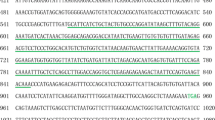Abstract
Toll-like receptor 3 (TLR3) plays a key role in activating immune responses during viral infection. To study the genes involved in the regulatory function of TLR3 in the rare minnow Gobiocypris rarus after viral infection, a full-length cDNA of TLR3 (GrTLR3) with a splice variant (GrTLR3s) was identified by homologous cloning and RACE techniques. The antiviral effector molecule Mx gene was cloned and partially sequenced. The mRNA expression levels of GrTLR3, GrTLR3s, and Mx were studied in different tissues before and after virus infection by real-time quantitative RT-PCR. The transcripts of all three genes in liver were significantly increased following GCRV infection (P < 0.05). The mRNA levels in liver were upregulated at 24 h post-injection for GrTLR3 and GrTLR3s, and at 12 h for Mx. The upregulated expression levels were several folds for GrTLR3s, tens of folds for GrTLR3, and hundreds of folds for Mx. By semi-quantitative RT-PCR, GrTLR3 and Mx expressed at all the developmental stages, whereas GrTLR3s could only be detected at later developmental stages. Using RNAi and transgenic techniques, GrTLR3 mediated Mx expression but GrTLR3s did not. The time-dependent upregulation of receptor and effector, and the Mx over-expression dependent on TLR3, indicated that GrTLR3 regulated Mx expression in viral infection through a configuration change in rare minnow, and its splice variant did not contribute to the process.






Similar content being viewed by others
References
Aderem A, Ulevitch RJ (2000) Toll-like receptors in the induction of the innate immune response. Nature 406:782–787
Alexopoulou L, Holt AC, Medzhitov R, Flavell RA (2001) Recognition of double-stranded RNA and activation of NF-κB by Toll-like receptor 3. Nature 413:732–738
Baoprasertkul P, Peatman E, Somridhivej B, Liu Z (2006) Toll-like receptor 3 and TICAM genes in catfish: species-specific expression profiles following infection with Edwardsiella ictaluri. Immunogenetics 58:817–830
Bell JK, Mullen GE, Leifer CA, Mazzoni A, Davies DR, Segal DM (2003) Leucine-rich repeats and pathogen recognition in Toll-like receptors. Trends Immunol 24:528–533
Bertolino P, Holz LE (2007) Toll-like receptor-3 and the regulation of intrahepatic immunity: implications for interferon-alpha therapy. Hepatology 45:250–251
Bilak H, Tauszig-Delamasure S, Imler JL (2003) Toll and Toll-like receptors in Drosophila. Biochem Soc Trans 31:648–651
Blom N, Sicheritz-Ponten T, Gupta R, Gammeltoft S, Brunak S (2004) Prediction of post-translational glycosylation and phosphorylation of proteins from the amino acid sequence. Proteomics 4:1633–1649
Choe J, Kelker MS, Wilson IA (2005) Crystal structure of human Toll-like receptor 3 (TLR3) ectodomain. Science 309:581–585
Dhara A, Saini M, Das DK, Swarup D, Sharma B, Kumar S, Gupta PK (2007) Molecular characterization of coding sequences and analysis of Toll-like receptor 3 mRNA expression in water buffalo (Bubalus bubalis) and nilgai (Boselaphus tragocamelus). Immunogenetics 59:69–76
Edelmann KH, Richardson-Burns S, Alexopoulou L, Tyler KL, Flavell RA, Oldstone MB (2004) Does Toll-like receptor 3 play a biological role in virus infections? Virology 322:231–238
Funami K, Matsumoto M, Oshiumi H, Akazawa T, Yamamoto A, Seya T (2004) The cytoplasmic ‘linker region’ in Toll-like receptor 3 controls receptor localization and signaling. Int Immunol 16:143–154
Haller O, Frese M, Kochs G (1998) Mx proteins: mediators of innate resistance of RNA viruses. Rev Sci Tech 17:220–230
Heinz S, Haehnel V, Karaghiosoff M, Schwarzfischer L, ller MM, Krause SW, Rehli M (2003) Species-specific regulation of Toll-like receptor 3 genes in men and mice. J Biol Chem 278:21502–21509
Ishii A, Kawasaki M, Matsumoto M, Tochinai S, Seya T (2007) Phylogenetic and expression analysis of amphibian Xenopus Toll-like receptors. Immunogenetics 59:281–293
Jault C, Pichon L, Chluba J (2004) Toll-like receptor gene family and TIR-domain adapters in Danio rerio. Mol Immunol 40:759–771
Jensen LE, Whitehead AS (2004) The 3′ untranslated region of the membrane-bound IL-1R accessory protein mRNA confers tissue-specific destabilization. J Immunol 173:6248–6258
Jensen I, Albuquerque A, Sommer A, Robertsen B (2002) Effect of poly I:C on the expression of Mx proteins and resistance against infection by infectious salmon anaemia virus in Atlantic salmon. Fish Shellfish Immunol 13:311–326
Kadowaki N, Ho S, Antonenko S, Malefyt RW, Kastelein RA, Bazan F, Liu YJ (2001) Subsets of human dendritic cell precursors express different Toll-like receptors and respond to different microbial antigens. J Exp Med 194:863–870
Kariko K, Ni H, Capodici J, Lamphier M, Weissman D (2004) mRNA is an endogenous ligand for Toll-like receptor 3. J Biol Chem 279:12542–12550
Kracht M, Saklatvala J (2002) Transcriptional and post-transcriptional control of gene expression in inflammation. Cytokine 20:91–106
Letunic I, Copley RR, Pils B, Pinkert S, Schultz J, Bork P (2006) SMART 5: domains in the context of genomes and networks. Nucl Acids Res 34:D257–D260
Mak TW, Yeh W (2002) Immunology: a block at the toll gate. Nature 418:835–836
Matsumoto M, Funami K, Oshiumi H, Seya T (2004) Toll-like receptor 3: a link between toll-like receptor, interferon and viruses. Microbiol Immunol 48:147–154
Medzhitov R (2001) Toll-like receptors and innate immunity. Nat Rev Immunol 1:135–145
Meijer AH, Krens SFG, Rodriguez IAM, He S, Bitter W, Snaar-Jagalska BE, Spaink HP (2004) Expression analysis of the Toll like receptor and TIR domain adaptor families of zebrafish. Mol Immunol 40:773–783
Muzio M, Bosisio D, Polentarutti N, D’amico G, Stoppacciaro A, Mancinelli R, van’t VC, Penton-Rol G, Ruco LP, Allavena P, Mantovani A (2000) Differential expression and regulation of Toll-like receptors (TLR) in human leukocytes: selective expression of TLR3 in dendritic cells. J Immunol 164:5998–6004
Nishiya T, Kajita E, Miwa S, DeFranco AL (2005) TLR3 and TLR7 are targeted to the same intracellular compartments by distinct regulatory elements. J Biol Chem 280:37107–37117
Nygaard R, Husgård S, Sommer AI, Leong JAC, Robertsen B (2000) Induction of Mx-protein by interferon and double-stranded RNA in salmonid cells. Fish Shellfish Immunol 10:435–450
Oshiumi H, Tsujita T, Shida K, Matsumoto M, Ikeo K, Seya T (2003a) Prediction of the prototype of the human Toll-like receptor gene family from the pufferfish, Fugu rubripes, genome. Immunogenetics 54:791–800
Oshiumi H, Matsumoto M, Funami K, Akazawa T, Seya T (2003b) TICAM-1, an adaptor molecule that participates in Toll-like receptor 3 mediated interferon-beta induction. Nat Immunol 4:161–167
Phelan PE, Mellon MT, Kim CH (2005) Functional characterization of full-length TLR3, IRAK-4, and TRAF6 in zebrafish (Danio rerio). Mol Immunol 42:1057–1071
Renshaw M, Rockwell J, Engleman C, Gewirtz A, Katz J, Sambhara S (2002) Cutting edge: impaired Toll-like receptor expression and function in aging. J Immunol 169:4697–4701
Rodriguez MF, Wiens GD, Purcell MK, Palti Y (2005) Characterization of Toll-like receptor 3 gene in rainbow trout (Oncorhynchus mykiss). Immunogenetics 57:510–519
Rudd BD, Burstein E, Duckett CS, Li X, Lukacs NW (2005) Differential role for TLR3 in respiratory syncytial virus-induced chemokine expression. J Virol 79:3350–3357
Salio M, Cerundolo V (2005) Viral immunity: cross-priming with the help of TLR3. Curr Biol 15:R336–R339
Sarkar SN, Smith HL, Rowe TM, Sen GC (2003) Double-stranded RNA signaling by Toll-like receptor 3 requires specific tyrosine residues in its cytoplasmic domain. J Biol Chem 278:4393–4396
Schroder M, Bowie AG (2005) TLR3 in antiviral immunity: key player or bystander. Trends Immunol 26:462–468
Schwede T, Kopp J, Guex N, Peitsch MC (2003) SWISS-MODEL: an automated protein homology-modeling server. Nucl Acids Res 31:3381–3385
Shapiro MB, Senapathy P (1987) RNA splice junctions of different classes of eukaryotes: sequence statistics and functional implications in gene expression. Nucl Acids Res 15:7155–7174
Su J, Ni D, Song L, Zhao J, Qiu L (2007) Molecular cloning and characterization of a short type peptidoglycan recognition protein (CfPGRP-S1) cDNA from Zhikong scallop Chlamys farreri. Fish Shellfish Immunol 23:646–656
Sullivan C, Postlethwait JH, Lage CR, Millard PJ, Kim CH (2007) Evidence for evolving Toll-IL-1 receptor-containing adaptor molecule function in vertebrates. J Immunol 178:4517–4527
Tissari J, Sirén J, Meri S, Julkunen I, Matikainen S (2005) IFN- enhances TLR3-mediated antiviral cytokine expression in human endothelial and epithelial cells by up-regulating TLR3 expression. J Immunol 174:4289–4294
Wang T, Liu P, Chen H (1994) Preliminary study on the susceptibility of Gobiocypris rarus to hemorrhagic virus of grass carp (GCHV). Act Hydrobiol Sin 18:144–149 (In Chinese, English abstract)
West AP, Koblansky AA, Ghosh S (2006) Recognition and signaling by Toll-like receptors. Ann Rev Cell Dev Biol 22:409–437
Xu Y, Tao X, Shen B, Horng T, Medzhitov R, Manley JL, Tong L (2000) Structural basis for signal transduction by the Toll/interleukin-1 receptor domains. Nature 408:111–115
Yang E, Shin JS, Kim H, Park HW, Kim MH, Kim SJ, Choi IH (2004) Cloning of TLR3 isoform. Yonsei Med J 45:359–361
Zuany-Amorim C, Hastewell J, Walker C (2002) Toll-like receptors as potential therapeutic targets for multiple diseases. Nat Rev Drug Discov 1:797–807
Acknowledgement
The authors would like to thank Ms. Ming Li and Mr. Renxiang Yan for fish administration and microinjection, and Ms. Shangping Chen and other laboratory staff for technical advice and helpful discussions. We are grateful to Dr. Yonghong Wang from CSIRO for critically reading the manuscript. This study was supported by the National Natural Science Foundation of China (30428024, 30540084 and 30740009), 973 National Basic Research Program of China (2006CB102100 and 2004CB117406), Chinese Academy of Sciences project (KSCX2-YW-N-021), research foundation (08080262, 08080245 and 01140508) from Northwest A&F University in China, China Postdoctoral Science Foundation (20070410298), and the grant from the State Key Laboratory of Freshwater Ecology and Biotechnology (2007FB09).
Author information
Authors and Affiliations
Corresponding author
Rights and permissions
About this article
Cite this article
Su, J., Zhu, Z., Wang, Y. et al. Toll-like receptor 3 regulates Mx expression in rare minnow Gobiocypris rarus after viral infection. Immunogenetics 60, 195–205 (2008). https://doi.org/10.1007/s00251-007-0264-0
Received:
Accepted:
Published:
Issue Date:
DOI: https://doi.org/10.1007/s00251-007-0264-0




